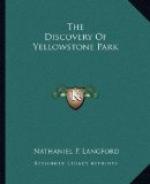[Footnote Y: Called now Kepler’s cascade.]
[Footnote Z: An incident of so amusing a character occurred soon after my return to Helena, that I cannot forbear narrating it here. Among the specimens of silica which I brought home were several dark globules about the size of nutmegs. I exhibited these to a noted physician of Helena, Dr. Hovaker, and soon after the return of Mr. Gillette from his search for Mr. Everts, I called upon him at his store and exhibited to him these specimens of silica. At the same time I took a nutmeg from a box upon the store counter, and playfully asked Gillette, in the presence of Dr. Hovaker, if he had found any of those singular incrustations. Dr. Hovaker, believing of course that the specimen I held in my hand came from the Yellowstone, took the nutmeg, and with wonder exhibited in every feature, proceeded to give it a critical examination, frequently exclaiming: “How very like it is to a nutmeg.” He finally took a nutmeg from a box near by, and balanced the supposed incrustation with it, declaring the former to be the lighter. Asking my permission to do so, he took the nutmeg (which he supposed to be an incrustation) to a jeweler in the vicinity, and broke it. The aroma left him no doubt as to its character, but he was still deceived as to its origin. When I saw him returning to the store, in anticipation of the reproof I should receive, I started for the rear door; but the Doctor, entering before I reached it, called me back, and in a most excited manner declared that we had discovered real nutmegs, and nutmegs of a very superior quality. He had no doubt that Yellowstone lake was surrounded by nutmeg trees, and that each of our incrustations contained a veritable nutmeg. In his excitement he even proposed to organize a small party to go immediately to the locality to gather nutmegs, and had an interview with Charley Curtis on the subject of furnishing pack animals for purposes of transportation. When, on the following day, he ascertained the truth, after giving me a characteristic lecture, he revenged himself by good naturedly conferring upon the members of our party the title, by which he always called them thereafter, of “Nutmegs.”
N.P. LANGFORD.]
[Footnote AA: James Bridger was famous for the marvelous stories he was accustomed to relate of his mountain life and experiences. He once told me that he had seen a river which flowed so rapidly over the smooth surface of a descending rock ledge in the bottom of the stream, that the water was “hot at the bottom.” My experience in crossing the Firehole river that day, leads me to believe that Bridger had had, at some time, a similar experience. He well knew that heat and fire could be produced by friction. Like other mountain men, he had doubtless, many a time, produced a fire by friction; and he could not account for the existence of a hot rock in the bed of a cold stream, except upon the theory that the rapid flow of water over the smooth surface evolved the heat, by friction.




